Click on images to enlarge
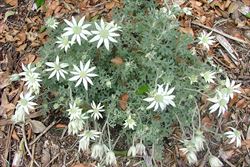
habit (Photo: Sheldon Navie)
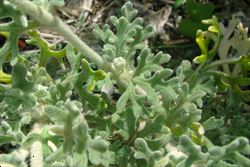
hairy stems and deeply-divided leaves (Photo: Sheldon Navie)
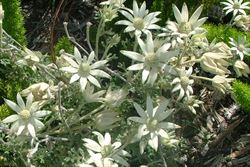
daisy-like flower clusters (Photo: Sheldon Navie)
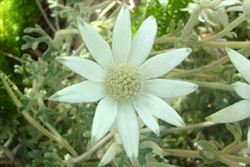
close-up of flower cluster, with green-tipped bracts that resemble petals (Photo: Sheldon Navie)
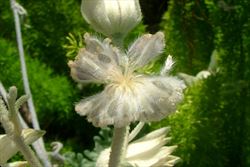
close-up of seeds, which are covered with long silky hairs (Photo: Sheldon Navie)
Scientific Name
Actinotus helianthi Labill.
Family
Apiaceae (Queensland, New South Wales, the ACT, Victoria, Tasmania, Western Australia and the Northern Territory)Umbelliferae (South Australia)
Common Names
flannel flower, Sydney flannel flower
Origin
This species is native to eastern New South Wales and some inland parts of south-eastern and central Queensland. In Queensland it is found as far north as inland from Rockhampton, but it is mainly present in the Darling Downs district. In New South Wales it is quite widespread and common in coastal areas (north of the Ulladulla district) and is also found on the western slopes (as far west as Narrabri).
Cultivation
This species is widely cultivated in eastern Australia for is distinctive foliage and attractive 'daisy-like' flowers. Its desirability as a garden plant is also enhanced by the fact that it is native to this part of the country, but it is also grown well beyond its native range. Flannel flower (Actinotus helianthi) is also being increasingly grown and marketed for the cut flower industry.
Several cultivars of this species have been developed in recent years, the most popular of which is Actinotus helianthi 'Federation Star'. This cultivar became popular after it was chosen as the New South Wales floral emblem for the Centenary of Federation in 2001. Other cultivars include Actinotus helianthi 'Starbright', Actinotus helianthi 'Summer Cloud', Actinotus helianthi 'Parkes Star' and Actinotus helianthi 'Lucky Star'. The latter cultivar is a long-stemmed variety that was specifically developed for the cut flower trade.
Naturalised Distribution
Flannel flower (Actinotus helianthi) has become naturalised near Cranbourne on the Mornington Peninsula in southern Victoria, but is not yet very widespread or common. There are also unconfirmed reports that it may have become naturalised beyond its native range on South Stradbroke Island, on the Gold Coast, in south-eastern Queensland.
Habitat
Flannel flower (Actinotus helianthi) grows naturally in coastal heath and scrub communities and in open woodlands (i.e. dry eucalypt forests). It prefers warmer temperate conditions, while in sub-tropical south-eastern Queensland it is generally found in cooler inland regions. Within these climatic regions it is mostly found growing in shallow sandy soils or in exposed rocky locations.
In Victoria, it has so far become naturalised in coastal districts on sandy soils.
Habit
An upright (i.e. erect) and short-lived or long-lived (i.e. annual or perennial) species usually growing 30-90 cm tall, but occasionally reaching up to 1.5 m in height in some conditions.
Distinguishing Features
- an upright herbaceous plant that is densely covered with short soft hairs that give it a woolly or flannel-like appearance.
- its greyish-green leaves are deeply divided into several narrow segments.
- its 'flowers' (2.5-8 cm across) closely resemble a daisy but are actually a dense cluster of tiny flowers surrounded by several spreading bracts.
- its distinctive white or creamy flowering bracts have greenish tips and are densely covered in short soft hairs.
- its small fruit are somewhat flattened and covered with long silky hairs.
Stems and Leaves
The whole of the plant is densely covered in short, soft, white or brownish-coloured hairs that give it a woolly or flannel-like appearance.
The leaves are simple and alternately arranged along the stems (up to 5 cm long and 5 cm wide), but they are deeply divided into several narrow (i.e. linear to oblong-linear) segments. Each leaf is borne on a stalk (i.e. petiole) 8-50 mm long and is usually greyish-green in colour due to the dense covering of matted hairs (i.e. it is tomentose). The narrow leaf segments (15-30 mm long by about 5 mm wide) usually have rounded tips (i.e. obtuse apices).
Flowers and Fruit
The flowers are borne in a dense cluster (i.e. umbel) 12-20 mm across that is surrounded by a ring of large petal-like bracts. This inflorescence (25-80 mm across in total) closely resembles a 'daisy' and may be easily confused with a flower-head (i.e. capitulum) at first glance. These flower clusters are borne on stalks (i.e. peduncles) up to 8 cm long at the tips of the stems. The individual flowers in the central cluster (i.e. umbel) are tiny and white to creamish in colour. These flowers do not have any petals and are borne on short stalks (i.e. pedicels) 3-4 mm long. The outermost flowers in the cluster are male (i.e. they only have stamens) while the inner ones have both male and female parts (i.e. they are bisexual). The 10-18 radiating bracts (2-4 cm long) which surround these tiny flowers are also white or creamy in colour with greenish tips. They are densely covered in short hairs and are very soft to the touch. Flowering occurs throughout the year, but peaks during spring (i.e. from September to November).
The small fruit (3.2-5 mm long and 1.8-2.8 mm wide) are egg-shaped to rounded in shape (i.e. ovate to circular) and somewhat flattened (i.e. compressed). They are covered with long silky hairs, are slightly five-ribbed, and contain a single seed.
Reproduction and Dispersal
This species reproduces entirely by seed. These seeds may be dispersed in dumped garden waste or in discarded cut flowers. The silky hairs on the fruit may also allow them to be spread by wind or become attached to animals and clothing.
Environmental Impact
Flannel flower (Actinotus helianthi) is regarded as an environmental weed Victoria, where it has invaded some coastal areas. It is mainly regarded as a threat because it colonises and grows very well in sandy soils and exposed sites beyond its natural habitat.
This species is currently of most concern to the south-east of Melbourne and is included in the list of environmental weeds for the Mornington Peninsula Shire. Though this species is has not yet had a significant impact as an environmental weed, it is seen as a potential threat to one or more vegetation formations in Victoria.
Legislation
Flannel flower (Actinotus helianthi) is not declared or considered noxious by any state or territory government in Australia.
Similar Species
This species is quite distinctive, but may be confused with other flannel flowers (i.e. Actinotus spp.). However, the other flannel flowers (i.e Actinotus spp.) generally have smaller flower clusters that are less than 3 cm across.
Flannel flower (Actinotus helianthi) may also be confused with several species of native and introduced 'daisies' (i.e. members of the Asteraceae family). However, these species do not have a dense covering of hairs on their 'petals' (i.e. ray florets) and they also have one or more rows of bracts surrounding the base of their flower-heads.

